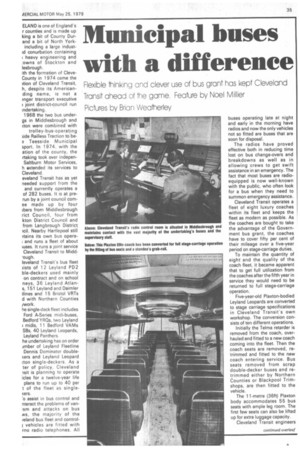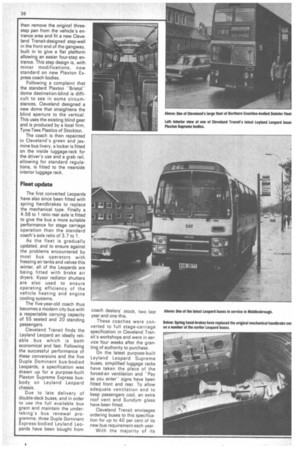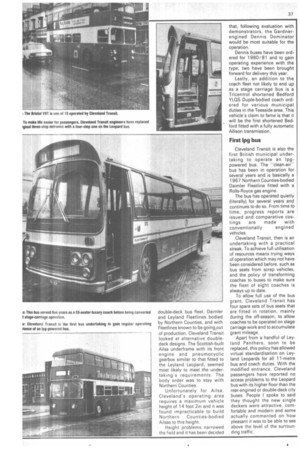Municipal buses with a difference
Page 37

Page 38

Page 39

If you've noticed an error in this article please click here to report it so we can fix it.
Flexible thinking anc clever use of bus grant has kept Cleveland Transit ahead of e game. Feature by Noel Millier Pictures by Brian Weatherley
ELAND is one of England's r counties and is made up king a bit of County Durand a bit of North York including a large industd conurbation containing heavy engineering and :owns of Stockton and lesbrough.
ith the formation of CleveCounty in 1974 came the ition of Cleveland Transit, h, despite its Americanding name, is not a :nger transport executive joint district-council run ,ndertaking.
1968 the two bus undergs in Middlesbrough and (ton were combined with
trolley-bus-operating iide Railless Traction to be3 Teesside Municipal sport. In 1974, with the ation of the county, the rtaking took over indepenSaltburn Motor Services, h extended its services to Cleveland.
eveland Transit has as yet needed support from the and currently operates a of 282 buses. It is at prerun by a joint council cornee made up by four ibers from Middlesbrough rict Council, four from kton District Council and from Langbrough District
Nearby Hartlepool still itains its own bus operaand runs a fleet of about iuses. It runs a joint service Cleveland Transit to MiddT .ough.
leveland Transit's bus fleet ;ists of 12 Leyland PD2 ble-deckers used mainly on contract and on school neys, 36 Leyland Allans, 151 Leyland and Daimler Hines and 15 Bristol VRTs d with Northern Counties 'work.
he single-deck fleet includes Ford A-Series midi-buses, Bedford YRCts, two Leyland midis, 11 Bedford VAMs SBs, 40 Leyland Leopards, Leyland Panthers.
he undertaking has on order imber of Leyland Fleetline Dennis Dominator doubleKers and Leyland Leopard ;ton single-deckers. As a ter of policy, Cleveland 'sit is planning to operate icles for a twelve-year life plans to run up to 40 per t of the fleet as singleKers.
'o assist in bus control and nteract the problems of vansm and attacks on bus Ns, the majority of the (eland bus fleet and controlI vehicles are fitted with rno radio telephones. All buses operating late at night and early in the morning have radios and now the only vehicles not so fitted are buses that are soon for disposal.
The radios have proved effective both in reducing time lost on bus change-overs and breakdowns as well as in allowing crews to get swift assistance in an emergency. The fact that most buses are radioequipped is now well-known with the public, who often look for a bus when they need to summon emergency assistance.
Cleveland Transit operates a fleet of eight luxury coaches within its fleet and keeps the fleet as modern as possible. As the coaches are bought to take the advantage of the Government bus grant, the coaches have to cover fifty per cent of their mileage over a five-year period on stage-carriage duties.
To maintain the quantity of eight and the quality of the. coach fleet, it became apparent that to get full utilization from the coaches after the fifth year in service they would need to be returned to full stage-carriage operation.
Five-year-old Plaxton-bodied Leyland Leopards are converted to stage carriage 'specifications in Cleveland Transit's own workshop. The conversion consists of ten different operations.
Initially the Telma retarder is removed from the coach, overhauled and fitted to a new coach coming into the fleet. Then the coach seats are removed, retrimmed and fitted to the new coach entering service. Bus seats removed from scrap double-decker buses and retrimmed either by Northern Counties or Blackpool Trimshops, are then fitted to the vehicle.
The 11-metre (36ft) Plaxton body accommodates 55 bus seats with ample leg room. The first few seats can also be lifted up for extra luggage capacity.
Cleveland Transit engineers then remove the origine! threestep pan from the vehicle's entrance area and fit a new Cleveland Transit-designed step-well in the front end of the gangway, built in to give a flat platform allowing an easier four-step entrance. This step design is, with minor modifications, now standard on new Plaxton Express coach bodies.
Following a complaint that the standard Plaxton "Bristol" dome destination-blind is difficult to see in some circumstances, Cleveland designed a new dome that straightens the blind aperture to the vertical. This uses the existing blind gear and is produced by a local firm, Tyne-Tees Plastics of Stockton.
The coach is then repainted in Cleveland's green and jasmine bus livery, a locker is fitted on the inside luggage-rack for the driver's use and a grab rail, allowing for standard regulations, is fitted to the nearside interior luggage rack.
Fleet update
The first converted Leopards have also since been fitted with spring handbrakes to replace the mechanical type. Finally a 4.56 to 1 ratio rear axle is fitted to give the bus a more suitable performance for stage carriage operation than the standard coach's axle ratio of 3.7 to 1.
As the fleet is gradually updated, and to ensure against the problems encountered by most bus operators with freezing air tanks and valves this winter, all of the Leopards are being fitted with brake air dryers. Kysor radiator shutters are also used to ensure operating efficiency of the vehicle heating and engine cooling systems.
The five-year-old coach thus becomes a modern city bus with a respectable carrying capacity of 55 seated and 20 standing passengers.
Cleveland Transit finds the Leyland Leopard an ideally reliable bus which is both economical and fast. Following the successful performance of these conversions and the five Duple Dominant bus-bodied Leopards, a specification was drawn up for a purpose-built Plaxton Supreme Express busbody on Leyland Leopard chassis.
Due to late delivery of double-deck buses, and in order to use the full available bus grant and maintain the undertaking's bus renewal programme, three Duple Dominant Express-bodied Leyland Leopards have been bought from coach dealers' stock, two last year and one this.
These coaches were converted to full stage-carriage specification in Cleveland Transit's workshops and were in service four weeks after the granting of authority to purchase.
On the latest purpose-built Leyland Leopard Supreme buses, simplified luggage racks have taken the place of the forced-air ventilation and ''Pay as you enter" signs have been fitted front and rear. To allow adequate ventilation and to keep passengers cool, an extra roof vent and Sundym glass have been fitted.
Cleveland Transit envisages ordering buses to this specification for up to 40 per cent of its new bus requirement each year.
With the majority of its double-deck bus fleet, Daimler and Leyland Fleetlines bodied by Northern Counties, and with Fleetlines known to be gong out of production, Cleveland Transit looked at alternative doubledeck designs. The Scottish-built AiIse underframe with its front engine and pneumocyclic gearbox similar to that fitted to the Leyland Leopard, seemed most likely to meet the undertaking's requirements. The body order was to stay with Northern Counties.
Unfortunately for AiIse, Cleveland's operating area requires a maximum vehicle height of 14 foot 2in and it was found impracticable to build Northern Counties-bodied Ailsas to this height.
Height problems narrowed the field and it has been decided that, following evaluation with demonstrators, the Gardnerengined Dennis Dominator would be most suitable for the operation.
Dennis buses have been ordered for 1980/81 and to gain operating experience with the type, two have been brought forward for delivery this year.
Lastly, an addition to the coach fleet not likely to end up as a stage carriage bus is a Tricentrol shortened Bedford YLQS Duple-bodied coach ordered for various municipal duties in the Teesside area. This vehicle's claim to fame is that it will be the first shortened Bedford fitted with a fully automatic Allison transmission.
First lpg bus
Cleveland Transit is also the first British municipal undertaking to operate an lpgpowered bus. The "clean-air" bus has been in operation for several years and is basically a 1967 Northern Counties-bodied Daimler Fleetline fitted with a Rolls-Royce gas engine.
The bus has operated quietly (literally) for several years and continues to do so. From time to time, progress reports are issued and comparative costings are made with conventionally engined vehicles.
Cleveland Transit, then is an undertaking with a practical streak. To achieve full utilisation of resources means trying ways of operation which may not have been considered before, such as bus seats from scrap vehicles, and the policy of transforming coaches to buses to make sure the fleet of eight coaches is always up to date.
To allow full use of the bus grant, Cleveland Transit has four spare sets of bus seats that are fitted in rotation, mainly during the off-season, to allow coaches to be operated on stage carriage work and to accumulate grant mileage.
Apart from a handful of Leyland Panthers, soon to be replaced, this policy has allowed virtual standardisation on Leyland Leopards for all 11-metre bus and coach duties. With the modified entrance, Cleveland passengers have reported no access problems to the Leopard bus with its higher floor than the rear-engined or double-deck city buses. People I spoke to said they thought the new single deckers were attractive, comfortable and modern and some actually commented on how pleasant it was to be able to see above the level of the surrounding traffic.




























































































































